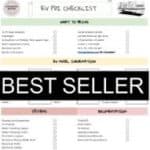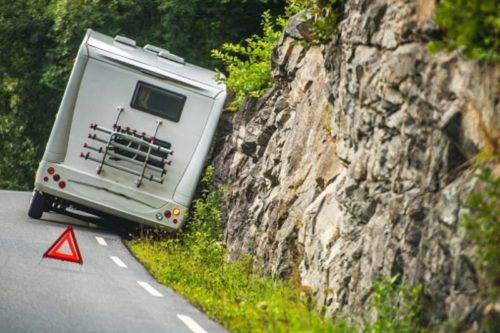So you’re shopping for a handicap-accessible RV?
Some news: There are no ADA requirements for Recreational Vehicles. If you have limited physical mobility, you may find it difficult to purchase a handicap-accessible RV.
However, there are options. Let’s run through a few!
Handicap-accessible RVs aren’t just for wheelchair users. They are also for elderly travelers who simply may not possess their full range of motion or sense of balance. Big steps, cramped passages, and dinette conversions all increase the difficulty of using a standard RV.
As someone who works in the RV industry, I’ll help you understand what options are out there. Yes, you can purchase a stock wheelchair-accessible RV – but there are very few. Most modifications are made aftermarket. And sadly, neither option is particularly affordable.
But even if you don’t plan on ordering a custom handicap-accessible RV, I can at least give you some pointers about what to look for in a standard floor plan.
Let’s dig in!
AT-A-GLANCE: WHAT OPTIONS EXIST FOR HANDICAP-ACCESSIBLE RVS?
Before we get into the weeds, I just want to highlight the overall state of the industry.
I wish I could report differently, but most RVs just aren’t designed for people with limited physical mobility. (In fact, the first manufactured mobility motorhome wasn’t introduced until 2012 by Newmar!) You may be required to crank a manual tongue jack, hike up 11” entry stairs, flip a dinette table top, crawl across a bed, or even ascend a ladder!
This is a particular problem because many retirees want to enjoy RVing in their Golden Years, and being required to lift a 40-lb propane tank isn’t preferable (or sometimes possible!).
Unfortunately, there isn’t strong industry pressure to pivot in a different direction. Most manufacturers can’t or won’t justify the upfront cost of producing more accessible models.
Plus, America’s aging campgrounds haven’t kept pace with their aging users. In fact, Mark Douglass, former CEO, had to close the doors of the RVing Accessibility Group non-profit due to COVID-era pandemic economic pressures.
So it’s an uphill battle. But options do exist if you look hard enough!
WHAT TYPES OF RVS ARE THE MOST ACCESSIBLE?
Certain RV model types tend to be more disability-friendly. Most wheelchair-accessible floor plans are available on Class A motorhomes or toy haulers, for instance. You can also find several wheelchair-friendly Class B conversion vans.
Meanwhile, your typical travel trailer, 5th wheel, or Class C motorhome isn’t very accessible for wheelchair users or the disabled. The standard RV entry door is only 26” wide, for instance. And almost all standard RV showers are built on a shower platform on a raised platform or at least a 2” sill.
RVs without slide-outs don’t work well for mobility layouts. There just isn’t enough width between the walls! You need to look for a conventional RV, 96” to 102” wide, with at least one wall slide-out in the living area.

You have three basic options when looking for a handicap-accessible RV:
- Order a handicap-accessible RV from a major or boutique manufacturer
- Modify a stock RV with roll-in shower, adjustable counter tops, entry lift, grab handles, etc. as needed.
- Purchase a stock RV with the best layout for the mobility-impaired (not possible for wheelchair users.)
Your budget will determine your choice for you. Please understand that either ordering or customizing an RV for wheelchair accessibility will require a large financial investment. The most luxurious Newmar wheelchair-accessible motorhome, for instance, costs over $400,000!
WHO MANUFACTURES HANDICAP-ACCESSIBLE RVS?
- Winnebago and Newmar (owned by Winnebago) produce award-winning wheelchair-accessible motorhomes.



- Harbor View has developed a cult following as a boutique manufacturer of wheelchair-accessible travel trailers.
- Dune Sport has also generated a loyal following as a boutique manufacturer of wheelchair-accessible toy haulers.
- Sportsmobile, based in the American southwest, produces custom handicap-accessible Class B motorhomes and conversion vans.
- Maxvan Pathway builds wheelchair-accessible RVs off the Ram Promaster chassis.
There are many smaller conversion van companies, often specializing in Ram Promaster, Ford Transit, or Mercedes-Benz Sprinter chassis, which can outfit a van with a wheelchair-accessibility package as well.
Because these are custom-outfitted RVs, you will work directly with the designer to select your features and options.
For more details on choosing an RV manufacturer of handicap-accessible units, check out our article, “RV Model Floorplans If You Have Mobility Challenges.”
FEATURES TO LOOK FOR IN AN ACCESSIBLE RV

Open Concept Layout
Look for open-concept floor plans. If using a wheelchair, you will need an RV with at least one large sidewall slide-out, possibly two. You might even look for a full-wall slide, which can double your interior living space!
- Be careful if buying an RV with a kitchen island. There’s no guarantee there’s 36” of space surrounding the island!
- Look for a master bedroom with walkable access to both sides of the bed. Better yet, pick a layout with opposing twin beds.
- And at the risk of stating the obvious, make sure at least one side of the dinette is accessible by a wheelchair.
Single Floor Living
5th wheels typically have the main bedroom in the front of the camper on a raised platform, which requires ascending 3-5 stairs. And Class C campers may only have on bed in the cabover section. These layouts won’t work if someone uses a wheelchair.
If you can ascend stairs but are worried about falling, equip the stairway with full-length assist handles along both sides of the aisle. Put reflective tape or floor lighting along the stair treads so they can be easily seen at night.
Accessible Switches and Outlets
All RVs have a switch panel that controls common appliances like the water pump, water heater, furnace, lights, etc. There’s no guarantee this switch panel is at a standard 48” from floor level. Some are mounted just below the ceiling, above your head!
Similarly, outlets can be at any height, not just the standard 16” off the floor or 12” off the countertop. Double-check the locations!
Dry Bath
Unless you’re buying an RV with a roll-in wet bathroom specifically designed for wheelchair users, stay away from wet baths! These are normally seen in tiny travel trailers and Class B conversion vans, and there’s very little room to maneuver inside!
Flush Slide-Out
To avoid a tripping hazard, look for RVs with flush-floor slide-out systems.
Ramp or Lift
RVs designed (or modified) for wheelchair use will have extra-wide entry doors (36” minimum) and a long ramp.
That’s the minimum required. More posh RVs will have fully automatic lift systems. These may require double cargo doors, like a toy hauler.
Height of Appliances
Double-check the height of common appliances like the refrigerator, microwave, washer/dryer, and stove. The microwave, in particular, could be literally anywhere – it all depends on the floorplan.
Adjustable Dinette Tops
While it’s rare to find an RV with adjustable kitchen countertops, several RVs have adjustable-height dinettes.
Roll-Under Sink
You’ll almost never see a roll-under sink in a conventional RV, but they’re quite handy for wheelchair users. Most have a rolling storage cart underneath. With the cart removed, a wheelchair user can slide underneath the sink for easy access.
Accessible Shower
Again, roll-in showers are almost unknown outside of specific wheelchair-accessible models, such as from Winnebago or Newmar.
However, many stock showers can be modified to be more friendly to users with impaired mobility. You can install aftermarket grab handles, anti-slip mats, and plastic shower seat supports. Avoid cramped neo-angle showers with narrow 22” shower doors; look for bi-folding glass shower doors and rectangular shower pans.
Hand Controls
Virtually no stock RVs are equipped with hand controls rather than a steering wheel and foot pedals. This will require aftermarket customization.
SUMMARY: OPTIONS FOR BUYING A HANDICAP-ACCESSIBLE RV
You have three basic options when looking for a handicap-accessible RV:
- Order a handicap-accessible RV from a major or boutique manufacturer
- Modify a stock RV with roll-in shower, adjustable counter tops, entry lift, grab handles, etc. as needed.
- Purchase a stock RV with the best layout for the mobility-impaired (not possible for wheelchair users.)
I recommend calling manufacturers directly. Anyone who specializes in building accessible RVs will be more than happy to answer your questions!
Andy Herrick is a blogging nerd, #8 Enneagram, wannabe bread baker, INTJ, RV industry professional, and small business entrepreneur. He can be found hanging out with his lovely wife and family, skiing, cycling, climbing, hiking, and convincing anyone who will listen why dogs aren’t really that great of pets. Also, he runs this website.









